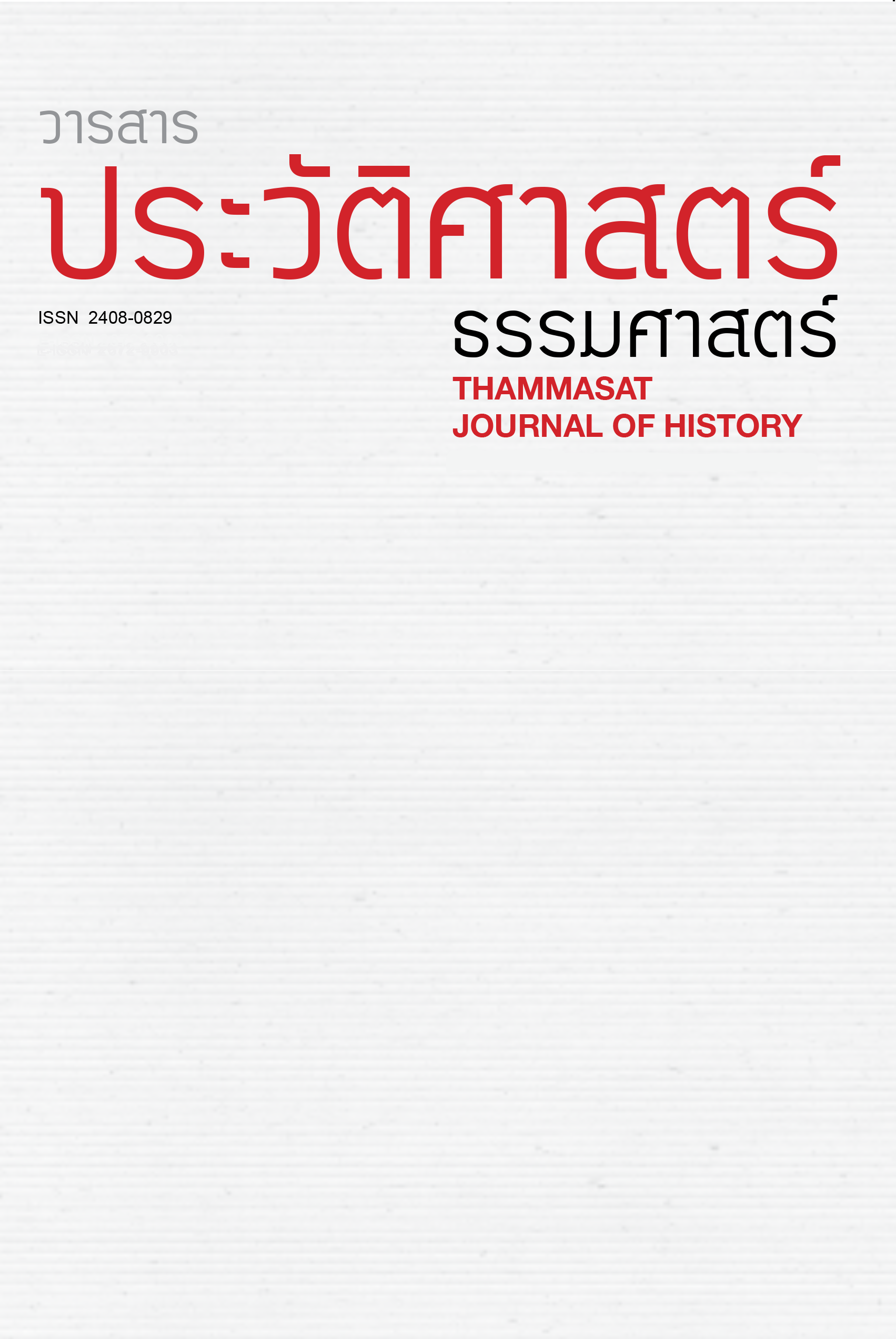แหล่งหลบลี้หนีภัยเซี่ยงไฮ้ : การอพยพของชาวยิวยุโรปจากนาซีเยอรมนี ค.ศ. 1933-1945
Main Article Content
บทคัดย่อ
บทความนี้ศึกษาปัจจัยที่ส่งผลให้ชาวยิวยุโรปอพยพเข้าสู่เซี่ยงไฮ้และปัจจัยที่มีอิทธิพลต่อการมีชีวิตรอดของผู้ลี้ภัยชาวยิวภายใต้การครอบครองเซี่ยงไฮ้ของญี่ปุ่นใน ค.ศ. 1933-1945 โดยการใช้วิธีการทางประวัติศาสตร์ในการศึกษาแหล่งข้อมูลที่เกี่ยวข้อง พบว่า ชาวยิวยุโรปอพยพเข้าเซี่ยงไฮ้หลังจากฮิตเลอร์ก้าวขึ้นสู่อำนาจในปี ค.ศ. 1933 และออกกฎหมายห้ามคนยิวรับราชการ นอกจากนี้ เหตุการณ์อันชลุส คริสทัลล์นัคท์ในปี 1938 และการยึดครองโปแลนด์ในปี 1939 ยังทำให้ชาวยิวตัดสินใจอพยพ เซี่ยงไฮ้ยังเป็นสถานที่ที่ดึงดูดผู้ลี้ภัยชาวยิวเนื่องจากไม่มีการต่อต้านชาวยิวในจีน และมีชาวยิวของชุมชนชาวยิวท้องถิ่นที่พร้อมช่วยเหลือผู้ลี้ภัย ยิ่งไปกว่านี้ เมื่อประเทศส่วนใหญ่ไม่ต้อนรับผู้ลี้ภัยชาวยิว เซี่ยงไฮ้กลายเป็นสถานที่สุดท้ายที่สามารถเข้าได้โดยไม่ต้องใช้วีซ่า ผู้ลี้ภัยชาวยิวมีชีวิตรอดภายใต้การครอบครองของญี่ปุ่นตั้งแต่ปี 1937 เพราะญี่ปุ่นต้องการหาประโยชน์จากชาวยิว เมื่อนาซีเยอรมนีเสนอแผน “การแก้ปัญหาครั้งสุดท้าย” ในปี 1942 ให้ทางการญี่ปุ่นกำจัดชาวยิวยุโรปในเซี่ยงไฮ้ ญี่ปุ่นก็ไม่ได้ปฏิบัติตามนาซี แต่บังคับผู้ลี้ภัยให้ไปอยู่ในเก็ตโต้ปี 1943 อย่างไรก็ตาม ญี่ปุ่นไม่ได้ฆ่าและทรมานชาวยิว ดังนั้น เซี่ยงไฮ้จึงเป็นแหล่งหลบลี้หนีภัยที่ช่วยรักษาชีวิตชาวยิวยุโรปเป็นจำนวนมาก
Article Details

This work is licensed under a Creative Commons Attribution-NonCommercial-NoDerivatives 4.0 International License.
ลิขสิทธิ์บทความเป็นของผู้เขียนและสงวนสิทธิ์ตามกฎหมาย
ข้อคิดเห็นใดๆ ที่ปรากฏในวารสารนี้เป็นของผู้เขียน คณะกรรมการวารสาร ภาควิชาประวัติศาสตร์ฯ กองบรรณาธิการ ตลอดจนกรรมการกลั่นกรองประจำฉบับ ไม่จำเป็นต้องเห็นพ้องกับข้อคิดเห็นเหล่านั้น
References
คัททิยากร ศศิธรามาศ. “การุญยฆาตในยุคนาซีเยอรมัน: บาดแผลที่ยังคงเจ็บปวด.” วารสารสังคมศาสตร์ มหาวิทยาลัยศรีนครินทรวิโรฒ 17 (มกราคม-ธันวาคม 2557): 249-260.
บรรพต กำเนิดศิริ. “ชาวยิวและศาสนายูดาห์ในช่วงเวลาแห่งการปลดแอก (ตั้งแต่ทศวรรษแรกของคริสต์ศตวรรษที่ 19 จนถึงช่วงเวลาเมื่อสงครามโลกครั้งที่ 1 อุบัติขึ้นในปี ค.ศ. 1914) โดยเน้นไปที่ดินแดนเยอรมัน : ความเป็นอันหนึ่งอันเดียวกันและความหลากหลาย.” วารสารยุโรปศึกษา 27, ฉ. 2 (กรกฎาคม-ธันวาคม 2564): 1-43.
ภครินทร์ เรืองศิริสุวรรณ. “ภาษาเหยียดเม็กซิกันของประธานาธิบดีโดนัล ทรัมป์ ในฐานะวาทศิลป์แบบเจ้าจักรวรรดิ.” สารนิพนธ์ปริญญามหาบัณฑิต, สาขาวิชาความสัมพันธ์ระหว่างประเทศ คณะรัฐศาสตร์ จุฬาลงกรณ์มหาวิทยาลัย, 2562.
อันโตนีโอ โฉมชา. “นาซีศึกษา : อ่านอดีตเพื่อเข้าใจปัจจุบันกับตุลย์ อิศรางกูร ณ อยุธยา.” The101.World. 6 ธันวาคม 2560. https://www.the101.world/tul-interview-nazi-study/.
Bresheeth, Haim, Litza Jansz, and Stuart Hood. Introducing the Holocaust: A Graphic Guide. London: Icon Books, 2013.
Cesarani, David. Final Solution: The Fate of the Jews 1933-1949. New York: St. Martin’s Press, 2016.
Cesarani, David. “Great Britain.” In The World Reacts to the Holocaust, edited by David S. Wyman, 693-748. Baltimore and London: Johns Hopkins University Press, 1996.
Eber, Irene. “Chinese Jews and Jews in China: Kaifeng – Shanghai.” In Religion in China: Major Concepts and Minority Positions, edited by Max Deeg and Bernhard Scheid, 65-89. Wien: Verlag der Österreichischen Akademie der Wissenschaften, 2015.
Eber, Irene. “Flight to Shanghai: 1938-1939 and Its Larger Context.” In Jews in China: Cultural Conversations, Changing Perceptions, edited by Kathryn Hellerstein, 54-68. PA: Pennsylvania State University Press, 2020.
Eber, Irene. Foreward to Shanghai’s Baghdadi Jews: A Collection of Biographical Reflections, by Maisie J. Meyer, 11-12. Hong Kong: Blacksmith Books, 2015.
Eber, Irene. “Overland and by Sea: Eight Centuries of the Jewish Presence in China.” In Jews in China: Cultural Conversations, Changing Perceptions, edited by Kathryn Hellerstein, 3-30. PA: Pennsylvania State University Press, 2020.
Fenby, Jonathan. The Penguin History of Modern China: The Fall and Rise of a Great Power 1850 to the Present. London: Allen Lane, 2008.
Friedlander, Saul. Nazi Germany and the Jews, vol. 1: The Years of Persecution, 1933-1939. New York: HarperCollins, 1997.
Gao, Bei. Shanghai Sanctuary: Chinese and Japanese Policy Toward European Jewish Refugees During World War II. Oxford and New York: Oxford University Press, 2013. Google Books.
Gruber, Samuel D. “The Continuing Exodus: The Synagogue and Jewish Urban Migration.” Religion 35 (2012): 14-19. Accessed June 8, 2024. https://surface.syr.edu/rel/35.
Guang, Pan. “Shanghai: a Haven for Holocaust Victims.” The Holocaust and the United Nations Outreach Programme (Discussion Paper Series) 2, no. 6 (2012): 65-75.
Guang, Pan. “Uniqueness and Generality: the Case of Shanghai in the Annals of Jewish Diaspora.” In From Kaifeng…to Shanghai: Jews in China, edited by Roman Malek, 437-445. Nettetal: Steyler Verl., 2000.
Kearney, Gerald David. “Jews under Japanese Domination, 1939-1945.” Shofar 11, no. 3 (Spring 1993): 54-69. Accessed April 21, 2024. http://www.jstor.org/stable/42941838.
Mitter, Rana. “The War Years, 1937-1949.” In The Oxford Illustrated History of Modern China, edited by Jeffrey N. Wasserstrom, 150-177. Oxford: Oxford University Press, 2016.
Sassoon, David S. D. “Inscriptions in the Synagogue in Kai-Fung-Foo.” The Jewish Quarterly Review 11, no. 2 (October 1920): 127-144. Accessed May 6, 2024. https://www.jstor.org/stable/1451389.
Schlor, Joachim. “Irgendwo auf der Welt: The Emigration of Jews from Nazi Germany as a Transnational Experience.” In Three-Way Street: Jews, Germans, and the Transnational, edited by Jay Howard Geller and Leslie Morris, 220-238. Ann Arbor: University of Michigan Press, 2016. https://www.jstor.org/stable/10.3998/mpub.9221214.13.
Tokayer, Marvin, and Mary Swartz. The Fugu Plan: The Untold Story of the Japanese and the Jews during World War II. New York: Paddington Press, 1979.
Medzini, Meron. Under the Shadow of the Rising Sun: Japan and the Jews during the Holocaust Era. Boston: Academic Studies Press, 2016.
Meyer, Maisie J. Shanghai’s Baghdadi Jews: A Collection of Biographical Reflections. Hong Kong: Blacksmith Books, 2015.
Meyer, Maisie J. “The Global Reach of Shanghai’s Baghdadi Jews.” In China and Ashkenazic Jewry: Transcultural Encounters, edited by Kathryn Hellerstein and Lihong Song, 145-164. Berlin: De Gruyter Oldenbourg, 2022.
Wang, Jian. “Tracking the Exact Number of Jewish Refugees in Shanghai.” In China and Ashkenazic Jewry: Transcultural Encounters, edited by Kathryn Hellerstein and Lihong Song, 129-143. Berlin: De Gruyter Oldenbourg, 2022.
Wyman, David S. “The United States.” In The World Reacts to the Holocaust, edited by David S. Wyman, 693-748. Baltimore and London: Johns Hopkins University Press, 1996.
Xu, Xin. “Jewish Communities and Modern China: Encounters of Modern Civilizations.” In China and Ashkenazic Jewry: Transcultural Encounters, edited by Kathryn Hellerstein and Lihong Song, 99-108. Berlin: De Gruyter Oldenbourg, 2022.
Xu, Xin. “Chinese Research on Jews in China.” In Sino-Judaica: Jews and Chinese in Historical Dialogue, edited by Aharon Oppenheimer, 15-26. Tel Aviv: Tel Aviv University, 1999.
Zhang, Yanhua, and Wang Jian. Preserving the Shanghai Ghetto: Memories of Jewish Refugees in 1940’s China. Translated by Emrie Tomaiko. California: Bridge21 Publications, 2016.

